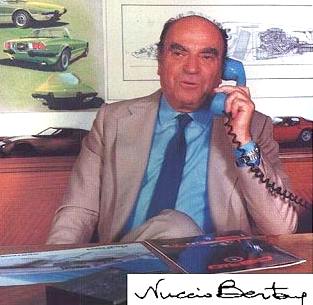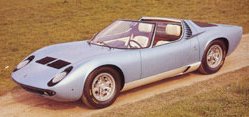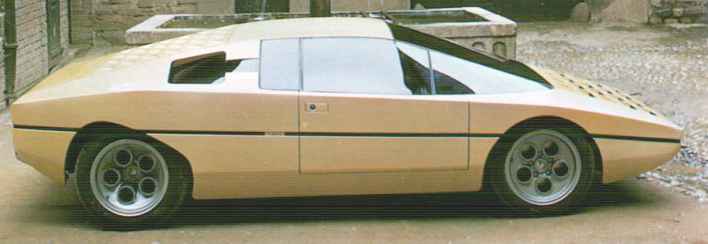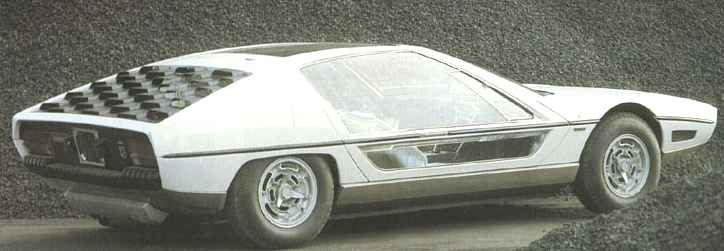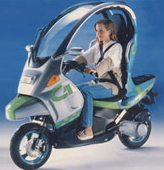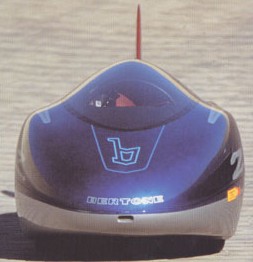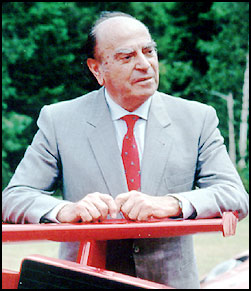|
||||
|
Almost every motor car is the product of many skilled persons. First comes the designer, then the welder, panel beater, etc, etc. Occasionally, one man designs and builds his own creations, but that is rare these days. But the start of it all is the human mind and the human hand. Prototypes start life as the seed of an idea, told to a wife or a friend over a drink. The idea moves the hand, the hand creates the prototype. Some men and women are gifted. Some can visualise an idea then convey that idea to paper, thence to metal and glass.
NUCCIO BERTONE
The Italian design and coachbuilding firm known today as Carrozzeria Bertone dates to 1912, the year Giovanni Bertone set up a carriage building and repair facility in Turin. Two years later, a son was born to the Bertone household, a son who would have a major impact on the, world of automotive design. He was Born in Turin on July 4, 1912.
Nuccio Bertone
However, Giuseppe "Nuccio" Bertone was not a designer, though he claimed to have styled a number of one-off cars in his early years with the family company. But the drawings, he said, were lost in a fire during World War II.
Giuseppe Bertone was nicknamed Nuccio. His father Giovanni founded Carrozzeria Bertone in 1914 after working as a carriage wheel-maker. Nuccio entered the family business while in his early twenties. Step-by-step, he transformed the small family workshop into a manufacturer of prototypes with an integrated design house. The company he built was able to assist car manufacturers with styling, models, engineering, prototype construction and production of up to 20,000 cars a year.
Nuccio Bertone, then 20, joined his father's business in 1934, the year the firm exhibited its special-bodied Fiat Ardita, the Superaerodinimica, at the Turin Auto Show. In the years following World War II, Nuccio Bertone raced Fiats, OSCAs, Maseratis, and Ferraris, an activity that taught him much about aerodynamics, cooling, and vehicle dynamics. At the 1952 Turin Auto Show, Bertone reached agreement with Chicago auto dealer Stanley Arnolt II to build 200 special-bodied MGs for sale in the U.S. Here the shape of the Bertone firm was determined: a combination of design and coachbuilding.
After the war, Nuccio became chief executive of Carrozzeria Bertone and called upon professional designers to run the styling center. Bertone and his team created some of the most important cars of the last century. He may have been the greatest nurturer of design talent in history.
His first chief designer was Franco Scaglione, a man who was already a well-known before joining Bertone. He was followed by Giorgetto Giugiaro and Marcello Gandini. The two young talents discovered by Nuccio later achieved international fame. Giugiaro was a charter member of the European Automotive Hall of Fame in 2000.
But no matter who worked for him, Nuccio was never completely satisfied with a new car. He left the drawing board to professional designers, but admitted that "many times I drove their pencils." Nuccio's typical approach to any design discussion: "I am pretty satisfied with the final results. Well, nothing is perfect. For example, I have been fighting with my designers about..."
Bertone Ferrari Coupe 1962
At the 1952 Paris Auto Show, Bertone attracted attention with an Abarth design that bore the first of the embryonic wings that would distinguish his later work. Asked to design a successor to the Disco Volante by Alfa Romeo, Bertone created the first of the designs that came to be known as the BAT cars on the Alfa 1900 Sprint chassis. BAT stood for Berlina Aerodinamica Technica and these cars' resemblance to the Batmobile was purely coincidental. In 1954, again at the Turin Show, Bertone showed the Storm Z, a car aimed at American tastes and built on a modified Dodge platform. He also showed the seventh of the BAT cars, but the most important Bertone offering was the Alfa Romeo Giulietta Sprint prototype, the first of a long series. The Bertone works would ultimately build more than 40,000 of these coupes.
In 1960, Bertone built more than 31,000 bodies, ranging from the Fiat 850 Spider to the Fiat Dino and Simca 1200S coupes, plus the Alfa Romeo Montreal and various Lamborghinis. Bertone design number 100, shown at the 1965 New York Auto Show, was a special Ford Mustang commissioned by Automobile Quarterly.
Bertone's company philosophy was summed up at the time of the Fiat 850's introduction: "Our role is the production of car bodywork on which we impose the styling trends, build prototypes, develop the design, the production methods, and the tooling. Naturally, we produce them in quantity."
Bertone also produced designs for Ferrari, a company generally associated with Pininfarina. These included two special-bodied 25OGT coupes and the 308GT4. He also created the Aston Martin DB4 Jet shown at the 1961 Geneva show.
Bertone Lamborghini Muira 1968
His memory for detail was legendary -- not only for design elements of all cars all over the world, but also for the names of the people he dealt with during nearly 60 years running Carrozzeria Bertone.
Under Nuccio's guidance, Carrozzeria Bertone produced numerous landmark sports cars, including the Lamborghini Miura, Espada and Countach; the Alfa Romeo Giulietta Sprint and Montreal; the Iso Grifo; Lancia Stratos; Fiat 850 Spider and the Dino Coupe.
The Bertone stylists also designed several high-volume cars, including the Daewoo Espero, Simca 1200S Coupe, Volvo 780 Coupe and the Citroen BX, ZX, Xantia, XM and Berlingo. Hundreds of influential show cars came out of Nuccio's studio. Among them were the Alfa BAT trio in the1950s and the Testudo, Carabo, Ramarro, Emotion and Karisma in later years.
On the production side, the Alfa Romeo Giulietta Sprint, originally conceived as a limited run of 500 units, became a huge success. Bertone built 40,000 units. The company also produced 140,000 units of the Fiat 850 Spider and 180,000 Fiat X1/9 spiders, which was remarkably successful in the USA.
If Nuccio had a regret it was Ferrari. "They have always been with Pininfarina and I never tried to disturb them," he once said. "We made a couple of one-off units on the 250 GT chassis and a production car, the 308 GTB4. I would have liked to have done more for Ferrari." He was also disappointed with how things turned out at Lamborghini. "It was a great company which suffered many, many troubles over the years," he said. "But in the good times we made great cars with them."
Bertone Lamborghini Bravo
BERTONE DESIGN
A car is a car if it is really a car, but what is a car? It could be simply a conveyance to move people from one point on this planet to another. Or, it could be something we like, an object of art. An engineering masterpiece or just poetry in motion.
From the X 1/9, the Stratos, the Navajo, the Ramarro, intriguing names, and cars, all of which examples of applied high tech come out of a modest, at times almost unknown, suburb of Turin. Turin the working city, as Bertone itself testifies, gives and keeps giving, teaches, applies itself, looks to the future, and fights to give life the dignity of work. Outsiders may be taken aback, but for the inhabitants of Turin this is a natural, almost obvious, way of life.
With the passing of time, the Bertone technical and industrial heritage has become a national treasure and an example to the world. And the work of the draughtsman and the panel beater (who has always felt on a par with the engineer, as is only right, and how it should be) is now channelled into creating unique products.
Bertone is a force to be reckoned with, a symbol, but above all it is a company that never stands still: and this is where its secret lies. The individual strands of this secret are its impressive designs, those immediately recognisable cars, which are the product of internal partnerships that blend the skills of designers and factory workers, draughtsmen and engineers, faithful both to the classic mechanical traditions as well as to creating design concepts which can border on science fiction. This is what inspires Bertone, and should indeed be an inspiration for all.
Making things by hand means addressing the cosmos, and you don't have to be an astronaut to know that this is the only way of life, of living together on this planet, of creating something meaningful.
Bertone Lamborghini Marzal
THE SIXTIES
The Sixties were the years of the Italian-style GT. Nuccio Bertone came up with five variations on the theme which would always be dear to his heart, in the shape of five extremely racy GT models: the Alfa Romeo 2600 Sprint, in coupé and cabriolet versions, two Ferrari 250 GTs, one named 'Wax' after the commissioning client, and the other for the Maestro's personal use, the Aston Martin DB4 GT "Jet" and the Maserati 5000 GT.
At the same time two new industrial partnerships were getting under way, with the work on the Simca 1000 Coupé and the BMW 3200 CS limited series, as was the important but unfortunate ASA 1000, better known as the "Ferrarina", or "little Ferrari" (as the project originated with Enzo Ferrari), which, despite the high expectations of the public, never made it to the market.
The Iso-Rivolta GT 300 and 340 and the Iso Grifo were also created in this period. Nuccio Bertone also designed a prototype cabriolet of the latter and a racing version known as the A3C. The Grifo years were also the years of the Corvair Testudo, driven personally by Nuccio Bertone to the Geneva Motor Show in 1963. The following year saw the Alfa Romeo Canguro, followed in 1965 by the Alfa Romeo Giulia GT, rightful heir of the Giulietta Sprint.
In the same year Carrozzeria Bertone experienced a major turning-point, with the launch of the Fiat 850 Spider. The commercial success of this model led Nuccio Bertone to increase the company's production capacity to 120 units per day (between 1965 and 1972 nearly 140,000 were produced). With the 850 Spider the company took a giant leap forward in terms of production volumes, from the 13,000 bodies produced in 1966 to nearly 30,000 in 1968, an increase of 40 percent.
The end of the Sixties saw the beginning of the partnership with Ferruccio Lamborghini that was destined to make history in the car world. The first vehicle to come out of this was the Miura, presented at the 1966 Geneva Motor Show, which reinvented the design concept of a high performance coupé. The Miura was followed by the Marzal (1967) and the Espada (1968). In the same period two other coupés appeared: the Alfa Romeo Montreal and the Fiat Dino Coupé, both out in 1967.
Bertone BMW cycle
From the beginning of the Eighties the Ritmo Cabrio and the X1/9 were produced and sold directly under the Bertone marque, meaning that the company was now responsible not only for production but also for the sales network and after-sales assistance for the two models.
THE NINETIES
Without abandoning its commitment to exploring the new languages of car design, Bertone entered the last decade of the century with its focus very much on technological innovations.
In 1993 the Opel Astra Cabrio and the Fiat Punto Cabrio went into production, with the entire production cycle for both cars at the Grugliasco factory: assembly of the bodywork, fitting of the mechanical components, paintwork and fittings. A complete production cycle, ending with the final testing process, which is carried out according to the procedures and standards of the commissioning companies.
Bertone ZER electric record car
Continuing its research into low environmental-impact vehicles, in 1994 Bertone presented the ZER (Zero Emission Record), a futuristic reinterpretation of the unforgettable Abarth 750 Record. Expressly conceived and created to yield the highest performance levels in the electric car sector, the ZER (which boasts a Cx of 0.11) set the world hour speed record (199.822 km in 60 minutes), and broke the 300 km/h barrier, setting a new world speed record for electric cars (with a top speed of 303.977 km/h).
In 1994, Carrozzeria Bertone became the first manufacturer in Italy to be awarded ISO 9001 quality certification. Meanwhile Nuccio Bertone did not turn his back on a past dedicated to bodywork and continued to design working prototypes: the Karisma (1994), a four-seater berlinetta on a Porsche base, the Kayak (1995), a coupé on a Lancia K base, the Slalom "coupé de chasse" on an Opel Calibra base, and the Enduro 4x4, an SUV on a Fiat Brava floorpan.
On 26 February 1997, on the eve of the Geneva Motor Show, Nuccio Bertone passed away, leaving the world to grieve "one of the greatest coachbuilders of the century, and international Maestro of Italian style" in the touching words of Fulvio Cinti, motoring journalist and car historian.
Despite his advancing age, Nuccio Bertone continued to be involved in the day-to-day operations, particularly on the design side. He would visit the design center in Caprie, northwest of Turin, often on Saturday mornings, "so as not to disturb the designers." But on Monday morning the designers found on their drawing boards Nuccio's observations and suggestions for every proposal. His last public appearance was in April 1996 at the Turin Motor show. He died in Turin on February 25, 1997 at the age of 82.
Giuseppe Nuccio Bertone
After the passing of Nuccio Bertone, Bertone continues to be a successful company, entering the third millennium with an exploration of state-of-the-art technologies such as drive-by-wire. It has been manufacturing the new generation of the Opel Astra Coupé since 1999, and the Opel Astra Cabrio was added in 2000, both designed by Stile Bertone in Caprie. Bertone also produces the C1 scooter for BMW, opening a brand new chapter in the history of individual mobility.
Throughout the 1960s, Bertone educated many young designers, among them Giorgetto Giugiaro, one of the leading designers of the present era. Nuccio Bertone's many contributions to automotive design are celebrated the world over. He received an award for lifetime automotive design achievement at the 1994 Vision Honored banquet.
The Website is sponsored by Solar Cola
|
||||
|
The
content of this website is copyright © and design copyright 1991 and
2006 Electrick Publications and NJK. All rights reserved. The bird |
||||
